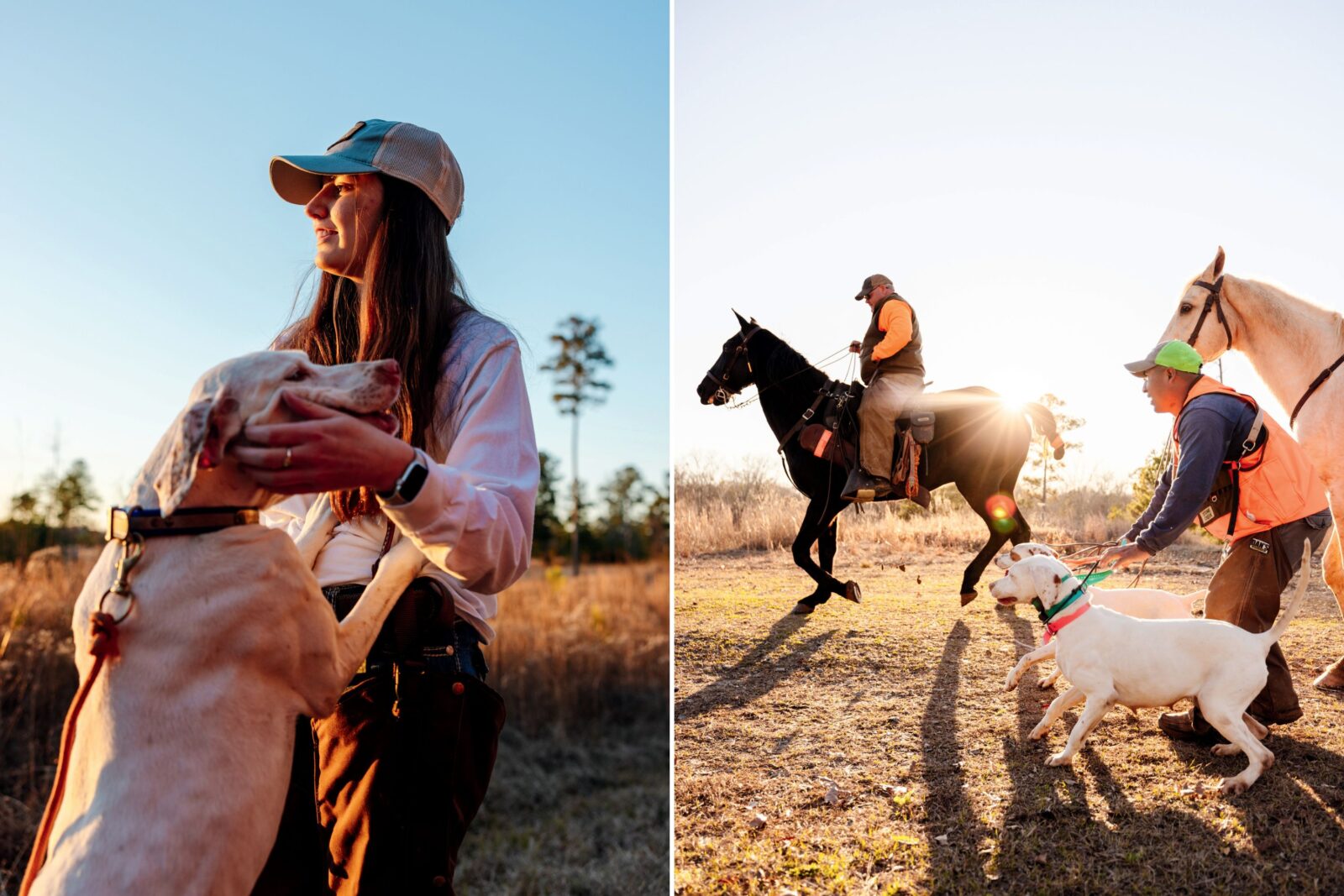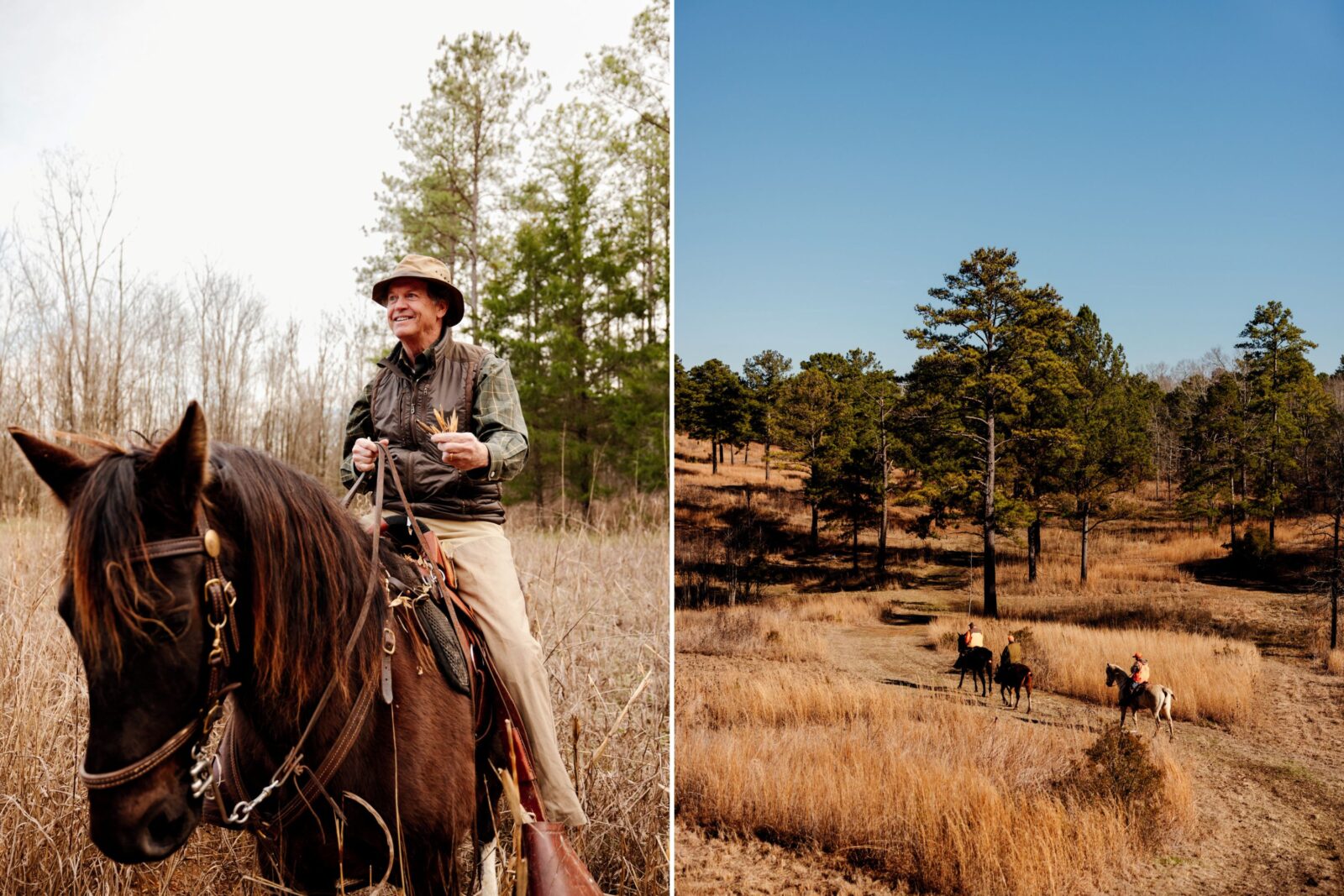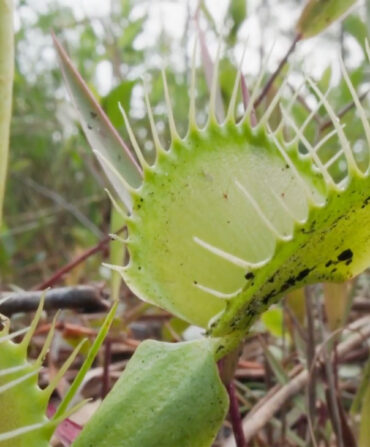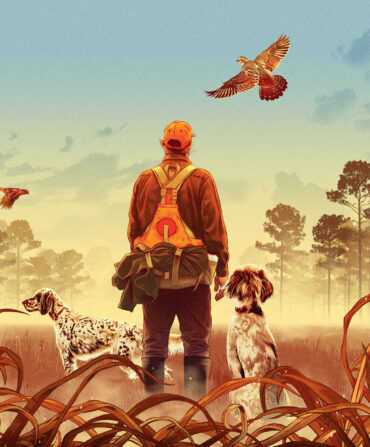Sporting
The Black Belt’s Quail Comeback
In the famed Alabama region, a rich tradition of quail hunting and dog work is enjoying a hard-won revival

Photo: COREY WOOSLEY
Dot, a pointer in training, on the hunt.
I had been carefully instructed: At Gusto, you shoot only the rise. You don’t track down the single bobwhite quail that rockets off on its own to land in a thicket a hundred yards away. You don’t go after the pairs and the triples and the busted coveys. You absolutely do not shoot birds that have not been pointed. Thomas Harris was gentle with the admonishment, but firm. Harris bought Gusto’s first 118 acres in 2004, and has spent the past two decades building what is now a 1,700-acre property and the Gusto experience with intentional precision. This is the way we do it, he had explained earlier, as we gathered in the sun-filled great room of his Gusto home, on the morning before the hunt. This is the only way we do it.

Photo: COREY WOOSLEY
Gusto Plantation owner Thomas Harris.
Which is why I’m knotted up a little more than usual when walking up on a pointed bird dog. Lady has her muzzle into the wind, half hidden by broom sedge, Indian grass, and bluestem canted over in the breeze. Two English cockers and a flushing Lab are working the cover when suddenly the covey—a big one, eighteen or twenty birds, at least—burst from the brush behind us. They’d doubled back on the dogs. They’ve beaten us at our own game.
“That’s what I like to see!” Harris says, beaming. “That’s what I call a fair fight.” Whatever frustration he might feel at the missed opportunity matters less than a greater design realized.
“We want this experience to be as authentic as possible,” Harris explains. “We want the fast-moving birds. We don’t chase them down. That’s how we hunted as kids—just walk up to the coveys and shoot the covey rise and then walk on to the next one. Because there was always a next one.”

Photo: Corey Woosley
Morning light through the loblollies at Shenandoah; the author with quarry in hand.
In my travels through Southern quail country, I’ve heard hunters say this time and time again, from Texas to Florida to Georgia to North Carolina. For so many, the experience of quail hunting in the mid-twentieth-century glory days, those of their youth, proved so formative that they have dedicated the later chapters of their lives to shaping and shepherding tracts of land that replicate their memories as closely as possible.
Big coveys, covey after covey, that come out of the cover in a whirlwind of feathers and beaks, atomizing in a 180-degree arc. Birds in every quadrant of the sky. That’s what Harris wants. That’s what he remembers. And that’s what he—along with a fascinating community of other quail fanatics, bird-dog devotees, and like-minded landowners—is working to create on one of the most intriguing pieces of quail ground in the South.
For five days in a glorious stretch of early February, I crisscrossed the Black Belt of Alabama, a region defined by geology and culture that girdles the state’s midsection, stretching some twenty-four counties from the Georgia state line to Mississippi’s. After flying into Montgomery, I headed first to the small town of Union Springs, touted as the “Bird Dog Field Trial Capital of the World”—a nickname bolstered by a lofty bronze statue of an English pointer on the town’s main drag, and a famed mural of bird dogs on point emblazoned on a historic downtown building. From there, I drove north, south, east, and west on country byways and the portion of U.S. 80 designated as the Selma to Montgomery National Historic Trail, so named to commemorate the landmark march in support of voting rights led by Martin Luther King Jr. I hunted on large private quail spreads and on one of the region’s eminent commercial hunting properties. I rode with the horse-mounted spectator galleries during some of the best-known field trials in the country. Most experiences occurred through a public-private nonprofit tourism and economic development outfit called Alabama Black Belt Adventures, which Harris founded in 2009. All were as invested in the future of quail-hunting culture as they were enamored of its past.
While there, I listened to story after story of one of the dreams that seem to bind the people and the history and the land of the Black Belt: bringing back a culture built on bobwhite quail. One late afternoon spent at a hunting property called Crossroad Farm, owned and managed by Hugh Thomas, a Birmingham businessman singularly focused on wildlife management, testified to that passion. After a few hours of touring horseback through pine fields and along tangled creek bottoms, we topped a soaring ridge where sunset cocktails awaited on picnic tables and a fire crackled.

Photo: COREY WOOSLEY
Relaxing on the quail buggy; a bronze statue of an English pointer in downtown Union Springs.
Thomas’s stepfather bought the spread in the 1970s, with his friends Jimmy Hinton Sr. (a Tuscaloosa businessman) and Alabama’s venerated coach Paul “Bear” Bryant. The land got broken up in the years that followed, but Thomas has since reunited more than fifteen hundred acres of the family tract.
“I thought I was going to be able to complete this dream of mine to bring back the wild quail on this land,” he said, looking over wide pastures ribboned with hardwoods. A handful of wild coveys existed on the property when he bought it, he recalled, but nothing like what the land had the potential to harbor. Nothing like the woods and fields of his youth. But now, after years of prescribed burns and methodically planned timber harvest, after calculating where best to manage for nesting habitat and escape cover and places for quail to raise their young, he recognizes his folly. “I’ve realized I won’t see the end of this unless I live to be as old as Methuselah,” he said, laughing wryly. “This is a generational thing. I’ve also learned that it has to start with someone, and I’m not giving up.”
It wasn’t quail hunting per se that cemented the Black Belt’s reputation. Field trials for bird dogs did that. The competitions have been held in the region for more than a century, but in some ways, the ball really got rolling in 1928. That’s the year Lewis Bergman Maytag, son of the founder of the eponymous appliance company, traveled from his home in Colorado to attend a local field trial in Alabama’s Bullock County. That he would make such a long journey underscored Maytag’s love of bird dogs and bird hunting, but in the Black Belt even he could hardly believe what he saw: A bird dog named Sun Ray pointed nine coveys of wild bobwhite quail in fifteen minutes. Astonished, Maytag left the field before the contest had even ended and headed for a bank in Union Springs to start buying land. Within two years, he had amassed a twelve-thousand-acre spread he named Sedgefields Plantation.

Photo: Corey Woosley
A quail feather caught post-flush at Shenandoah Plantation; riders saddle up at Sedgefields Plantation in Union Springs for the first brace of the morning at the National Open Shooting Dog Championship.
Maytag held his first major field trial on Sedgefields in 1937, and the property hosted trials by the Alabama Shooting Dog Club for years. In 1950, he helped form the National Shooting Dog Championship, the progenitor of what is now the National Amateur Free-for-All Championship. By its fifth year, the Sedgefields competition was attracting handlers and their bird dogs from ten states.
On the first morning of the seventy-fourth running of that trial, I saddled up to join the gallery of mounted spectators. A Free-for-All competition is an endurance race as much as a skills test. Two dogs in each brace compete head-to-head in heats that range from one to three hours long. And these dogs run—as far as three hundred yards in front of the judges and spectators. A dog handler on horseback oversees each dog, aided by a mounted scout who can roam widely to the sides of the course. A few dozen yards behind, a small group of judges follow, and another few dozen yards behind them come the gallery.
It is a spectacle. On my day afield, perhaps thirty mounted observers attended, in a parade of Carhartt coats and Barbour jackets, tattered leather fringe chaps and waxed cotton gone shiny with hard use. When the dogs were turned loose in the initial “breakaway,” the entire cavalry lurched forward to follow. Saddles creaked and croaked, horse hooves clopped, and a murmur of laughter and conversation swaddled the procession. The scene would repeat twice a day for the next week.

Photo: COREY WOOSLEY
Dot with her owner, youth field trial champion Addison McDuffie; turning loose a fresh brace.
Like most of the region’s large quail properties, Sedgefields’ terrain features sprawling pine savannas, with a lush ground cover of broom sedge and bramble. It’s big, open country for big-running dogs—I could see the two pointers nearly a quarter mile ahead, vaulting through the fields. As we rode, tall pines shattered early-morning sunlight into a million golden shafts. In the distance, the singsong cries of the dog handlers rang through the woods like sailors’ chanteys.
In most major field trials, dogs aren’t judged on the number of quail they find—there are too many external factors that can affect bird activity—but on how well they perform. The dogs need to range widely but still respond to their handlers. When they find birds and point, they can barely twitch, staying steady to the find and the shot as the handlers fire blank rounds.
In such a competition, with little room for error, a brace might last two minutes or three hours. For the gallery, that often means there’s plenty of time to socialize on horseback. For a while during my morning ride, I paired up stirrup to stirrup with a big fellow named Frank Rutland. He had a ruddy face, wire-rimmed bifocals, and a canvas shirt the color of cranberries. He began attending field trials here at age twelve, when Maytag still owned Sedgefields, he said, and five hundred horse-mounted observers would follow the bird dogs through their braces.

Photo: COREY WOOSLEY
The gallery of spectators.
Rutland won twenty-one different field trial championships in his career and hunted the Black Belt during those decades that fired the imaginations of so many current residents. “Understand that we didn’t have deer, turkeys, armadillos, or fire ants,” he told me. “But I’ll tell you what we did have: quail in numbers you wouldn’t believe. Your dog would push up a different covey before it could even get to the covey it smelled in the first place.”
And even today, despite the challenges facing field trials, with fewer participants, rising costs, and lands lost to development, I got the sense that Rutland and others don’t consider the pursuit of birds with dogs and horses and high hopes a throwback. This is their everyday real life in the Black Belt.
“This gets in your blood and you can’t get it out,” Rutland said. “I may be old, but I’m not stopping until I can’t get on a horse.”
There is a particular moment in quail hunting that I love more than all the others. It’s when a bird dog swaps ends in midair. It’s not common, but it’s unforgettable, and it happened in Alabama twenty feet in front of my horse.
A little pointer, Lucy, was running flat out, under tall columns of fire-blackened pines, when she hit bird scent while midair and in midstride. In a split second, she kicked her hindquarters to starboard and wrenched her front quarters to port, twisting 180 degrees while aloft. She hit the ground in a hard point, muzzle in a tangle of tawny grass and sawtooth oak, tail straight, body as rigid as corrugated washboard.

Photo: COREY WOOSLEY
English pointers Rebel and May in the field at Shenandoah.
I couldn’t help but whoop in delight. A midair end-swap is as pure a distillation of what a bird dog is capable of as I’ve ever seen. In that moment, Lucy’s breeding, instinct, desire, and training were all expressed in an instantaneous feat of athleticism. It was gravy that such a classic scene took place in one of the most classic Southern quail settings I’ve ever experienced.
We were coursing down the spine of one of the ridges that mark Shenandoah Plantation, about five miles west of Union Springs. One of the Black Belt’s numerous commercial quail-hunting operations, Shenandoah occupies a ribbed and rolling piece of landscape. Our horses picked their way along a hogback where hillsides fell away in thirty-foot embankments, flattening out into pines and tall grasses gridded with the mowed strips so common to managed quail grounds.
Gunning with me were country music songwriter and singer Kenton Bryant, and his buddy and fellow dog trainer David Stover. Bryant and I dismounted, pulled shotguns from leather scabbards, and moved in to the point. That’s another thing I love about quail hunting: Every player—pointer, flusher, gunner, guide—knows its role. Without a word, we moved into position. With Lucy on point, Shenandoah’s manager, Robert Moorer, called for his not-so-secret weapon.
“Kat!” he hollered. “Kat, here!”
From the dog wagon trailing the horses came a streak of furred lightning. Kat is half Labrador retriever and half Boykin spaniel, and 100 percent crazy about finding quail buried in the densest thickets. Moorer waded through the brush in front of Lucy, switching at the tall reeds with a leather strop, as Kat raced back and forth. She suddenly halted, crouched close to the ground, flanks quivering, and we knew the next act in this drama.

Photo: COREY WOOSLEY
Hugh Thomas, of Crossroad Farm; hunters on the trail at Shenandoah.
When the covey broke, Bryant and I brought the guns up swinging. There were feathers floating on his side of the stage, and a sheepish grin on mine, but I couldn’t feel disappointed. I was surrounded by horses and dogs and the smell of cordite. Suddenly a bald eagle soared overhead.
I burst out laughing. It was almost too perfect. I hollered over at Moorer: “You have that bird on the payroll?” You could not plan such a convergence of Southern quail archetypes.
Or perhaps, in the Black Belt, that’s exactly what they do.
From Shenandoah Plantation, I drove north through the tiny farming crossroads of Cecil, steering into the roadside parking lot of the Market at John E. Hall Store. The 1913 brick landmark operated as a general store into the 1990s but fell into disuse. Now a farm-to-table restaurant, market, and live-music venue, the joint offered quite the surprise. If I thought the sight of Lucy turning to stone in midair was worth remembering, lunch at the Market will go down in my personal culinary history. The special, offered the first Wednesday of every month, featured a single plump quail, stuffed with cornbread dressing and andouille sausage, deep-fried and topped with onion strings, all perched on a quivering foundation of grits and collard greens drizzled with tomato gravy. It was the best quail I’ve ever eaten, by a long stretch. The dish was created by the Market’s Grib Anderson, who grew up nearby and as a kid sold the country store the vegetables he grew in a backyard garden. He saved his profits in hopes of one day bankrolling an ambition he’d chronicled on a childhood notepad—to turn the dilapidated old store into a destination diner. I’d mark it down as another Black Belt dream realized.
The route west from Montgomery had me tucked just to the south of the Alabama River as it uncorks southwest across the state. I had one final destination on my list—Sedgefields Plantation of Alberta, Alabama, a different property than the Sedgefields I’d visited days earlier. For many, this Sedgefields represents a sort of Tigris and Euphrates of Black Belt quail heritage. The original seventy-five-hundred-acre estate was cobbled together in the 1920s and already a heralded field trial property when Jimmy Hinton Sr. purchased it in 1970. Known across the Black Belt simply as “Mr. Jimmy,” Hinton upheld Sedgefields as a showplace of field trial culture and lifestyle.

Photo: COREY WOOSLEY
A Tennessee walking horse snacks while the dogs are on point; inside the Market at the 1913-built John E. Hall Store, in Cecil.
The property became the home of the National Free-for-All Championship, in 1964, and the United States Open Quail Championship, in 1974. Later, Curt Gowdy filmed an episode of The American Sportsman there. Bear Bryant came several times a year when he wasn’t on the road. Bryant invested early with Hinton in the R.L. Zeigler Co., maker of the famed Zeigler wieners. The coach, in fact, was at Hinton’s Tuscaloosa home in January 1983, planning a hunt at Sedgefields, when he began to have chest pains. He left for a medical checkup at a local hospital, where he died the next day of a massive heart attack.
I arrived less than an hour before the Central Alabama Shooting Dog Association’s Jimmy Hinton Memorial field trial was slated to begin. Aromas of biscuits and sausage wafted from a sprawling white dining hall, surrounded by horse trailers and massive diesel-fueled dualies. There were fifty horses and hundreds of humans on the grounds, but all the attention seemed concentrated on the dogs. Each one boasted musculature like Roman sculpture—the ropy erector spinae along the spines, each tendon and ligament in their hindquarters defined, vertebrae like knots in cord. As handlers led them toward the breakaway line, they strained against their collars and leads with barely checked energy.
We had only a few minutes before Hinton’s son, Jimmy Hinton Jr., had to mount up for the first brace, so he walked me through a few rooms of the house he and his wife built in 2020. The manor looked as much like a trophy room and museum as a country home. On the walls of the main living room hung portraits of English pointers and black-and-white photographs of bird dogs posed behind marvelously ornate competition platters and bowls. Glittering trophies filled floor-to-ceiling display cases. Framed articles and plaques told the stories of some of the greatest dog trainers and handlers ever to compete in field trials: Clyde Morton, who began training dogs at Sedgefields in 1930, and won the National Grand Championship eleven times, a record that still stands; Ben “Man” Rand, born to sharecropper parents, who became one of the greatest field trial scouts in the game. Three of Jimmy Hinton Sr.’s bird dogs are in the Field Trial Hall of Fame, housed at the National Bird Dog Museum in Grand Junction, Tennessee. His name is on the Hall of Fame roster, as well.

Photo: COREY WOOSLEY
Morning breaks; a proud spaniel.
Dressed in worn canvas and jeans, the younger Hinton was clean-shaven and rangy, as bound up with nervous energy as one of his top-shelf bird dogs. Walking from room to room, he had the air of a man who, rather than boasting of his family’s accolades, knew how lucky he’s been. “All this…,” he said, the words trailing off as he struggled to articulate what Sedgefields meant to him. “We just love having people out here, that’s all,” he continued. “It’s always been like that. Daddy was like that. It wouldn’t be much fun to have all this down here and be by yourself.”
His bearing seemed to reflect what I’ve found bird hunting and field trialing and messing around with pointing dogs and guns and horses to be all about in the first place. All the fuss and feathers, the pageantry and polished silver, are rooted in a few exquisite moments that take place far from a country manor house or awards podium. There’s nothing fancy about it, really: A dog, a bird, a wild piece of untrammeled country, a breeze laden with an intoxicating scent—what happens next has shaped lives and forged friendships and broken hearts and inspired dreams. And most indelibly, transformed entire Southern landscapes.







